Back when I posted my Apple, Vodka and Birch Syrup Babka with Cranberry Mors Sorbet, I touched briefly on the history of babka. Still, it’s worth noting here that this yeast cake from Western Russia, Poland, and Ukraine gave birth to many variations, some of them dramatically different from the original. After reading through a great number of Eastern European babka recipes, I can basically sort them into three categories:
- First, there are the recipes that remain close to the original, a yeast dough often mixed with raisins and citrus peel. These are predominant in Polish cuisine, and you can still find a few in Ukrainian cookbooks too. And the Russian kulich is really the same as a babka. Several countries in Western Europe have their own traditional versions, such as the Gugelhupf.
- Later on (in the 19th century, apparently), some cooks decided they didn’t want to wait for that yeast dough to rise, and replaced the yeast with whipped egg whites. Most of today’s recipes for Czech bábovka are of this kind. But then, Ukrainians seem to have taken things one step further: with egg whites, the recipe starts getting closer to a soufflé, so why not reduce the amount of flour and make the two dishes even more similar? Thus the “modern” Ukrainian babka was born. The best definition I’ve found comes from Ukrainian Cuisine (Tekhnika Publishers, Soviet Union, 1975):
“Babkas differ from […] soufflés by their closer texture containing fewer bubbles of air. The ingredients going into babkas are cherries or apples, flour, egg yolks, cream, sugar and cinnamon. Babkas however, can be considered a relative of soufflés because whipped egg whites are also folded in and the mixture is also baked in oven.”
The dried fruits of the original are replaced with every possible dessert filling. The cookbook goes on with recipes for apple babka and cherry babka, then poppy seed babka, nut babka, cheese babka, cheese and almond babka, rye breadcrumb babka and buckwheat babka with cream, all of which incorporate whipped egg whites into the batter before baking. - Finally, Ukrainian cuisine takes a rather bizarre turn and we find several savory puddings with the name babka. Festive Ukrainian Cooking gives recipes for fish babka with horseradish sauce, and morel babka. These mixtures are still bound with whipped egg whites, which is probably why they’re considered babkas. There’s even a recipe for babka harbuzova, a pumpkin stuffed with rice, raisins and pumpkin purée — this time I have no clue why it’s called a babka!
Meanwhile, the babka’s popularity spread beyond Eastern Europe. The New York Jewish babka is a relatively close descendant of the original. It’s made from a yeasted dough with high egg and butter content, but the shape and the fillings have changed. Instead of dried fruits, cinnamon and chocolate have become the flavors of choice. Rather than being just mixed in the dough, they form layers, which requires changes to the way the cake is assembled: the dough is now rolled flat, covered with filling, rolled tightly, and folded to fit in a loaf pan.
While I was touring Jewish bakeries to research bialys, I also tried a few of the babkas sold by these venerable institutions. Many don’t make their own, and rely on commercial bakeries like Green’s — which explains why you can taste the exact same babka, with different labels, coming from different stores, often without even realizing. This is the case with Kossar’s. While I don’t know who actually makes it, their babka is fairly canonical. You can see plenty of thin layers, the loaf being clearly made by stacking two logs of rolled dough one on top of the other. The dark layers are quite generous but made with cocoa powder rather than chocolate. It’s not bad overall, but it’s too sweet, with a sticky mouthfeel that makes you thirsty. I like it slightly better warm.
So then I turned to Jewish cookbooks. There’s been a sort of babka renaissance in New York lately, but I’ll keep it for another post. Foremost, I wanted to crack the nut of the traditional chocolate babka, which is how I came across the book A Jewish Baker’s Pastry Secrets: Recipes from a New York Baking Legend, released a couple of years ago. Here was exactly what I needed, recipes so steeped in tradition that the author died before finishing the book (it was completed and published by his daughters). Recipes from a New York baking legend! Certainly, an illustrious baker whose babka must be sought the world over, his name on everybody’s lips: George Greenstein.
Well, all I can say is that for a New York baking legend, he must have been pretty discreet. He did win a James Beard award for his previous cookbook, published in 1993. However, he retired ages ago and the bakery he owned on Long Island has been gone for so long that the Internet itself doesn’t even remember it. The complete lack of references to Mr. Greenstein for anything other than his two books suggests that he was a legend mostly in his family kitchen. For the rest of New York, he must now be more like a myth, with very few living people able to claim to have tasted his elusive babka. Think I’m exaggerating? If you knew George Greenstein (and your last name is not Greenstein), please leave a comment.
But never mind how famous his babka was or wasn’t, the recipe has now been immortalized on paper, and anyone can give it a try!
Wait, wait, wait… It’s not so simple. In fact, it has to be the most complex babka recipe I’ve ever seen in all my research. As a good retired bakery owner, The Legend wrote his recipes as if he was still running a commercial Jewish bakery and was expecting you to do the same. There are several base preparations that a bakery has on hand at all (or most) times: streusel, almond paste, cake crumbs… You probably don’t have them at home. As a result, Greenstein’s chocolate babka recipe references no fewer than seven other recipes. Some of the referenced recipes are nested like Russian dolls: the babka requires processed almond-paste filling from page 32, which requires pure almond paste from page 31 and cake crumbs from page 42. And did I mention there are no pictures in the book? To make matters worse, every recipe is written with totally different yields, so you can be sure to end up with leftovers from every intermediary preparation. There are also errors in the yields, in the ingredient amounts, and in the instructions! I could do a favor to mankind just by rewriting this recipe legibly, because I would almost be willing to bet that nobody but me has ever made it as it is written now.
There’s also another problem. This is a recipe that packs all the flavors of a pastry shop into a single cake: chocolate, orange, cinnamon, nutmeg, vanilla, almonds, walnuts, crumbs… Many flavors are declined into multiple ingredients or preparations: the orange flavor comes from orange marmalade, orange zest, and orange juice; the chocolate flavor comes from melted chocolate, chocolate chips, and cocoa powder. There’s also milk, milk powder, and sour cream, which aren’t completely redundant, but each can only make a very marginal contribution. I counted about twenty ingredients in total. Not surprisingly, the resulting flavor profile is a mess.
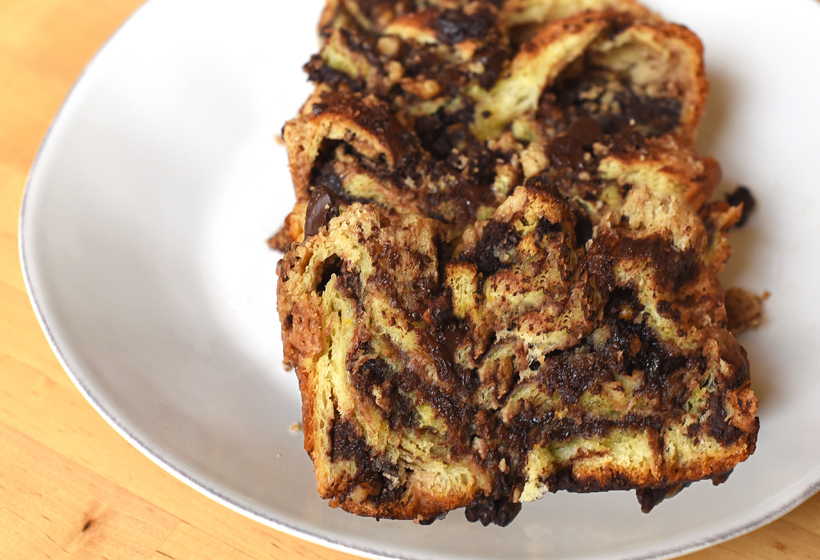
And yet… it’s actually a pretty good babka with a lot of potential. Here’s what like best about it:
- It’s crazy-loaded with filling. When you assemble it, you pile layer upon layer of filling on a thin layer of dough (which is already mixed with a copious amount of butter). If you like your babka super rich, this is the one for you. Believe me, you’re not gonna want to eat ice cream with it.
- Some of the flavors work well — just pick a couple instead of using them all! I liked the chocolate and orange pairing, which is of course a classic, but not something I’d tried in a babka before. And the chocolate flavor comes mostly from actual chocolate, with only a hint of cocoa powder.
- It boasts good texture contrast: you have the melty chocolate layers, the crunchy walnuts, the soft brioche-like dough, and more crunch from the streusel on top.
- The way the loaf is assembled results in thicker layers than in typical commercial babkas. It might be less aesthetically pleasing, but with this particular recipe, the babka tastes better like this. The thicker layers also give the dough the opportunity to rise more and get airier during baking.
Then there are the things I needed to fix:
- I’ve scaled all the sub-recipes appropriately (only the dough yields 2 babkas).
- I’ve kept only a few flavors: chocolate, orange, and walnuts; and I’ve added dark rum, as a nod to the rum baba. The recipe really doesn’t need anything else!
- I’ve done away with some of the ingredients that played little to no role in the recipe. For example, you no longer need to bake a separate cake just so you can make cake crumbs that then get mixed into almond paste. I feel like I could have gone even further — do we really need the milk powder and the orange zest? I also reduced the sugar because, like most American desserts, the original was too sweet.
- Finally, although I did keep Greenstein’s method of rolling and folding the babka, I’m having second thoughts… The layers are thick and I like that, but because the dough is twisted into a figure eight, slices from different portions of the cake tend to have very different dough-to-filling ratios. Maybe it’s fine and it just gives different options for everyone, chocoholics and pseudo-dieters alike. But I’m thinking we’d get much more even slices by just having 2 logs stacked one atop the another, instead of the figure eight twist.
Without further ado, here is my reinterpretation of Greenstein’s Legendary New York Chocolate Babka.
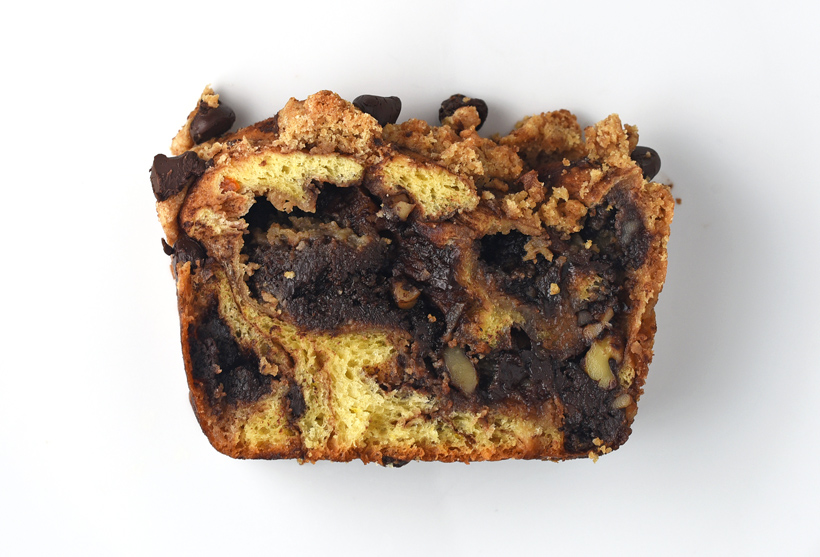
Babka sponge
Yields about 2 babkas
9 g active dry yeast
10 g sugar
20 g water, lukewarm
55 g milk, lukewarm
70 g bread flour
- In a small bowl, mix the yeast, sugar, water, and milk. Let rest 5 minutes.
- Transfer to the bowl of an electric mixer fit with the paddle attachment. Add the flour, and mix on low speed for 8 minutes, scraping the sides of the bowl a couple times. Cover with plastic wrap, and let rest for about 40 minutes, until doubled in volume.
Babka dough
Yields about 2 babkas
babka sponge
75 g egg
15 g egg yolk
20 g sugar
4 g nonfat dry milk powder
175 g bread flour
5 g salt
6 g orange zest, grated with Microplane grater
30 g dark rum
25 g orange marmalade (chunks chopped)
75 g butter, melted
- Remove the plastic wrap, and beat the sponge down with a few turns of the paddle. Mix in the egg and egg yolk on low speed.
- Add the sugar, milk powder, flour, salt, orange zest, rum, and marmalade, and mix on low speed for a minute.
- Scrape the sides of the bowl, switch to the dough hook, and knead for 8 minutes on low.
- Mix in the melted butter a little at a time. The dough should remain soft, moist, a little sticky, and have a silky appearance. Cover with plastic, and let rest for about an hour, until doubled in volume. Refrigerate overnight. The dough can be prepared a few days in advance.
Butter streusel
Yields about 120 g (1 babka)
20 g dark brown sugar
20 g granulated white sugar
40 g butter, cubed
50 g AP flour
1 pinch salt
10 g dark rum
- In the bowl of a stand mixer fit with the paddle attachment, add the brown sugar, white sugar, butter, flour, salt, and rum. Mix by pulsing on high speed in short bursts of about one second each. The ingredients should be combined but shouldn’t form a ball. Instead, the mixture should look like little pebbles, without much powder (sugar, flour) left at the bottom of the bowl.
- Transfer to a plastic container, and refrigerate.

Walnut paste
Yields about 170 g (1 babka)
55 g water
40 g sugar
80 g walnuts
1 pinch salt
45 g butter, softened
- In a small saucepan over medium heat, heat the water and sugar, and simmer until the sugar is fully dissolved into a syrup. Let cool for 5 minutes.
- In a blender, process the syrup, walnuts, and salt on high speed.
- Scrape the sides of the blender, add the butter, and blend again on high speed until smooth.
- Transfer to a plastic container, and refrigerate.
Chocolate babka
Yields 1 babka
200 g 64% bittersweet chocolate chips
15 g butter
55 g walnuts
AP flour (for dusting)
265 g babka dough
170 g walnut paste
70 g sugar
15 g cocoa powder
120 g butter streusel
- Place 3/4 of the chocolate chips in a plastic container with the butter. Heat in the microwave for 1 minute, and stir with a fork. Keep heating for 30 seconds at a time and stirring until the mixture has melted. Reserve.
- In a pan over medium heat, toast the walnuts until they start browning, shaking the pan regularly. Coarsely chop, and reserve.
- On a floured surface, roll the babka dough to a 25 cm x 18 cm rectangle, with its long side facing you. Make sure the bottom of the dough is well floured.
- Spread the walnut paste on the dough, leaving 1 cm around the sides and the top of the rectangle. Spread the chocolate mixture over the walnut paste.
- Mix together the sugar and cocoa powder in a bowl, then sprinkle on top of the layers of filling. Scatter the chopped walnuts on top as well.

- Tightly roll into a log, then twist and stretch to a length of about 45 cm. It’s okay if some of the filling leaks out.
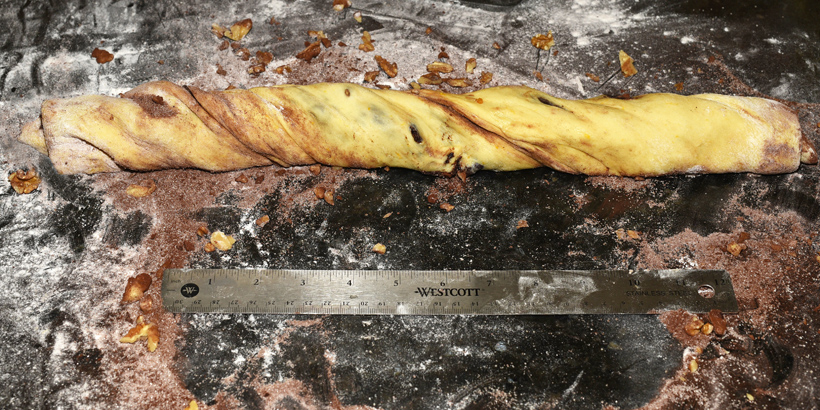
- Join the ends of the log to form a ring, and twist the ring to make a figure eight.
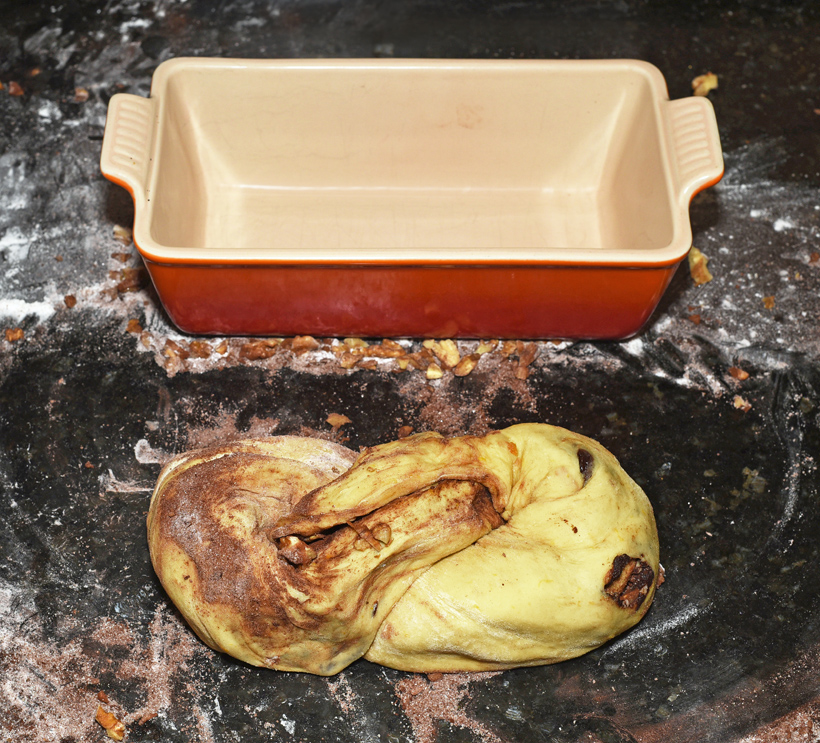
- Line a 10 cm x 22 cm x 7 cm loaf pan with parchment paper, and transfer the babka into it. Spray the top with a little bit of water, then sprinkle with any filling that may have leaked out of the dough while you were rolling, and top with the streusel. Cover with plastic wrap and let rise for about an hour, until the babka almost reaches the top of the loaf pan.
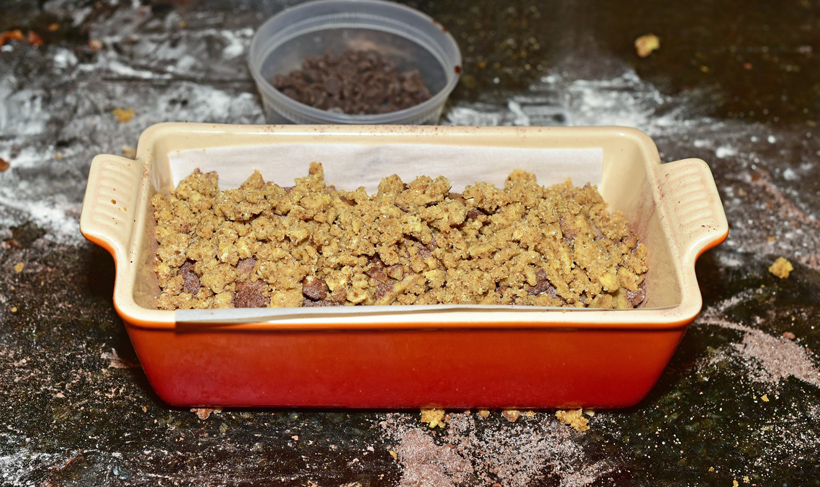
- Sprinkle the babka with the remaining chocolate chips. Bake in a 175 C / 350 F oven for 35-40 minutes (depending on your loaf pan; metal pans cook faster), until brown. The internal temperature of the cake should be at least 82 C / 180 F everywhere. Given the wide disparity of temperatures I’ve measured, it’s worth rotating the cake in the oven at least once during baking.
- Cool the babka, still in the loaf pan, on a wire rack.
- Once the babka reaches room temperature, cut into slices and enjoy! The babka can be kept in plastic wrap for a few days.

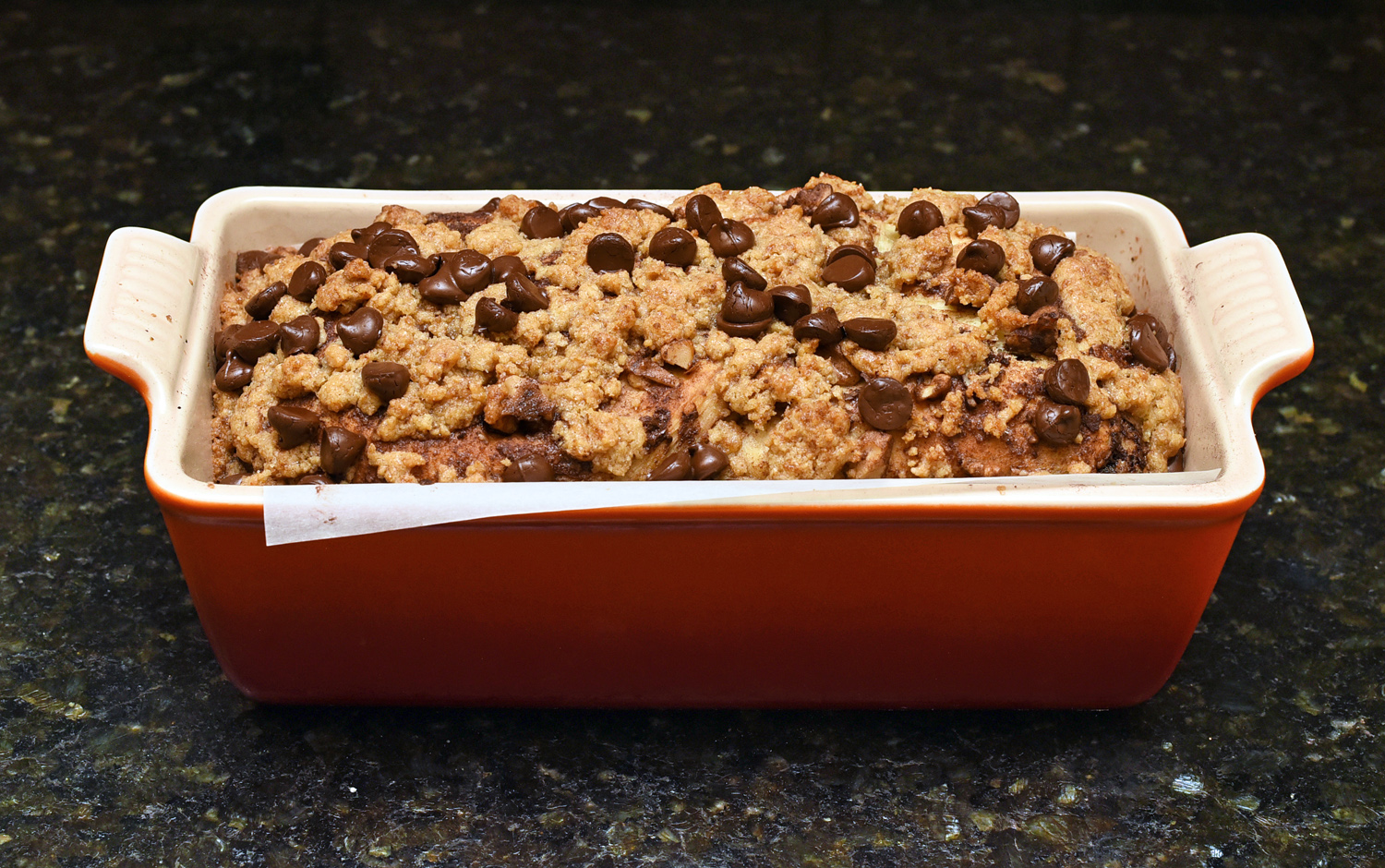
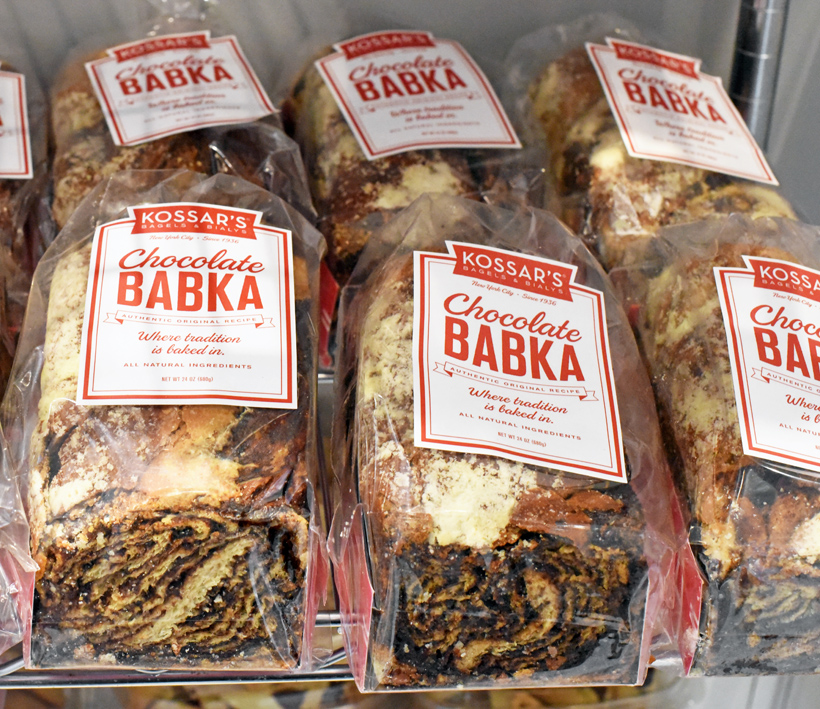
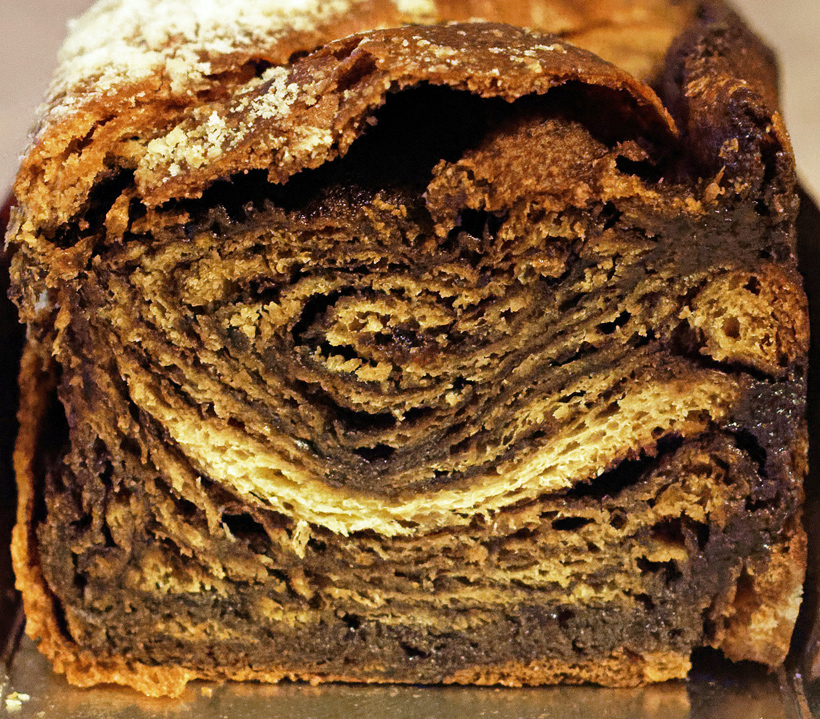
2 comments
Im so excited to try this recipe out! Amazing reproduction! Thank you
I’m a George Greenstein fan — he’s not famous, perhaps, but he was a bridge to an earlier era of NY Jewish baking. “Secrets of a Jewish Baker” (his first book) has what I feel are definitive recipes for challah and black & white cookies, and a number of minor recipes (like the one for crispy breadsticks) are also quite good. The ebook version goes on sale periodically for a few bucks — well worth picking up.
His second book was finished by others from his writing and notes. It might have been a better book had he lived long enough to complete it. (Or he had a great editor for the first who pushed him to make his recipes better — who knows?)
Yes, the recipe within a recipe within a recipe is a real pain since I don’t keep a stash of cake crumbs in my freezer. Making everything come out even is a bit much to ask though, because the same component recipe is usually used in different amounts by different recipes.
My babka collapsed as well. There’s probably a trick that he didn’t get a chance to write down.